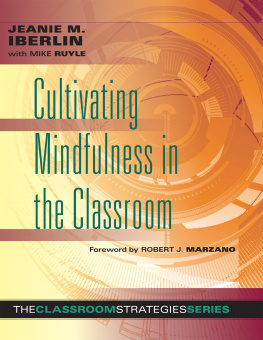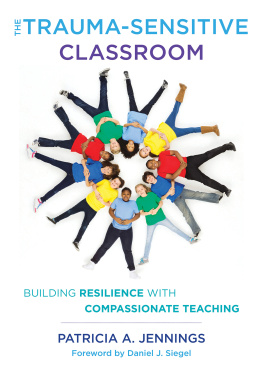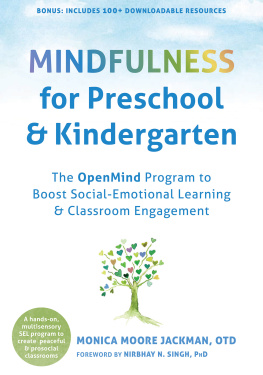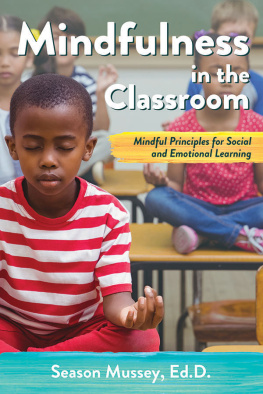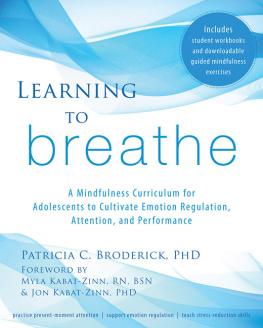Contents
Guide
Page List

THE NORTON SERIES ON SOCIAL EMOTIONAL LEARNING SOLUTIONS
PATRICIA A. JENNINGS, SERIES EDITOR
Mindfulness in the Secondary Classroom: A Guide for Teaching Adolescents
Patricia C. Broderick
SEL Every Day: Integrating Social and Emotional Learning with Instruction in Secondary Classrooms
Meena Srinivasan
Assessing Students Social and Emotional Learning: A Guide to Meaningful Measurement
Clark McKown
Mindfulness in the PreK5 Classroom: Helping Students Stress Less and Learn More
Patricia A. Jennings
Preventing Bullying in Schools: A Social and Emotional Learning Approach to Early Intervention
Catherine P. Bradshaw and Tracy Evian Waasdorp
NORTON BOOKS IN EDUCATION
Mindfulness in the Secondary Classroom
A Guide for Teaching Adolescents
PATRICIA C. BRODERICK

A Norton Professional Book
This e-book contains some places that ask the reader to fill in questions or comments. Please keep pen and paper handy as you read this e-book so that you can complete the exercises within.
Note to Readers: Models and/or techniques described in this volume are illustrative or are included for general informational purposes only; neither the publisher nor the author(s) can guarantee the efficacy or appropriateness of any particular recommendation in every circumstance.
For Connor, Owen,
Wesley, and Will
and for all our children

Contents

I am thrilled to introduce the first volume in this new book series from Norton Books in Education: SOCIAL AND EMOTIONAL LEARNING SOLUTIONS. The SEL Solutions Series features compact books for educators focused on recommended SEL practices from experts in the field. Cutting-edge research continues to confirm that instruction in social and emotional skills pays off in improved behavior and academic learning while students are in school, and that these skills continue to contribute to their success as adults. The books are intended to provide school leaders and classroom teachers with SEL tools and strategies that are grounded in research yet highly accessible, so readers can confidently begin using them to transform school culture, improve student behavior, and foster learning with the proven benefits of SEL.
As a former teacher and school leader, I am familiar with the challenge of finding the time to parse the theory and sift through research to identify the practices that will be effective in the classroom. The intention with this set of books is to circumvent this problem by tapping into the work of those who have already done the parsing and sifting: to have experts in the field of SEL present trustworthy concepts succinctly and emphasize applications and activities that can be implemented right away, without needing to adopt a separate program or curriculum. Our aim is to provide a set of quick, appealing, read-in-one-sitting guides to address different aspects of SEL implementation in classrooms, schools, and districts.
Patricia Brodericks book Mindfulness in the Secondary Classroom: A Guide for Teaching Adolescents is a magnificent overture to this new series. Drawing on her years of experience as a secondary teacher, mindfulness instructor, SEL program developer, and researcher, Broderick has woven a tapestry of important concepts and practical strategies to help educators promote whole-adolescent development. Recognizing that in SEL the teacher is the curriculum, she emphasizes the importance of adults as role models for the mindfulness, compassion, and social and emotional competencies we want our students to learn. Broderick highlights the importance of SEL development in adolescence, when our students are exploring identity, values, and lifes meaning, and she provides developmentally appropriate ways to introduce mindful awareness and compassion practices to support this developmental stage. As she notes, the risky behavior common to adolescents is usually rooted in an attempt to avoid unpleasant emotions; practicing mindfulness promotes the ability to accept such feelings, without judgement, and increases students ability to tolerate and work with their full range of emotions. Indeed, Brodericks years of research have proven that teaching developmentally appropriate mindful awareness and compassion practices to adolescents helps them learn to manage stress, improve emotion regulation, and promote their own well-being.
Patricia A. Jennings
Editor, Norton Series on Social and Emotional Learning Solutions

I wish to express my sincere gratitude to the teachers and other educational professionals I have been fortunate to meet through my work in the field of mindfulness in education. As a former secondary school teacher myself, I have deep admiration for the work they do and am inspired by the dedication this work requires. In their day-to-day interactions with students and families, these educators translate the values of service and love into something very present and very real. I hope this book offers them support and a set of practices that deepen their commitment and empower them in their lives. May the benefits of their own mindfulness practice accrue to the youth in their care and revitalize the institutions in which they work.
I also wish to thank Carol Collins, my editor at Norton, for her expertise and support as this book was being written. Her thoughtful suggestions have made this book a better one. Gratitude also goes to Tish Jennings, Series Editor, and to all the Norton staff: Kevin Olsen, Megan Bedell, Nicholas Fuenzalida, as well as Mariah Eppes and Sara McBride, whose careful attention to these chapters both clarified and improved the manuscript.
Finally, my deepest appreciation goes to my husband, my children, and grandchildren for their steadfast love, energy, and presence, and for the joy they bring to me in each moment.
Mindfulness in the Secondary Classroom
M indfulness is having a moment. From its place on the cover of Time magazine to its advocacy by celebrities, weve heard its praises sung by people from many different walks of life. But what is it, anyway? And, does it deserve all the hype? What, if anything, does mindfulness have to offer to teachers in secondary schools? If you reflect on some of the ways the term mindfulness has been used, you might conclude that its a gimmick or a quick fix. Its been used to describe products from cosmetics, to mayonnaise, to coloring books. Many previously innocuous activities, like working out or financial investing, are now publicized as mindful. Advertisers appear to be convinced that mindfulness sells, hence the remarkable ubiquity of the term.



